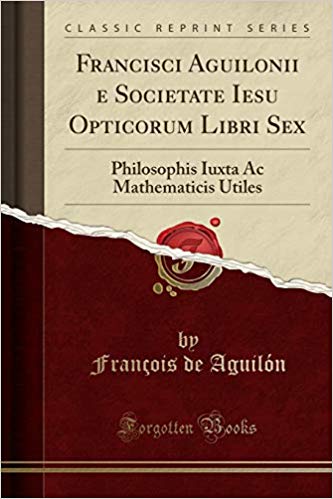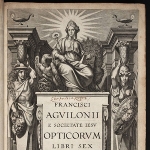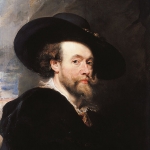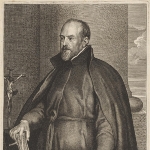François d'Aguilon was a Belgian Jesuit mathematician, physicist, and architect. He is noted for starting a special school for mathematics in 1611 at Antwerp, which produced Jesuit geometers such as Tacquet and de la Faille. He was also an author of the famous Opticorum libri sex philosophis juxta ac mathematicis utiles (Anvers, 1613), "Six Books of Optics, useful for philosophers and mathematicians alike".
Background
Ethnicity:
D'Aguilon`s family was a distinguished Spanish noble family.
François d'Aguilon was born on January 4, 1567, in Brussels to Pedro Aguilon, who was secretary to Philip II during an embassy to France. Nothing is known about the economic status of the family. It had to have been affluent at the least.
Education
François De Aguilon studied three years in the Jesuit College de Clermont in Paris (clearly secondary level for Aguilon). He then went to Douai for two years, and having completed the course in humanities, he began to study philosophy. (This would be the beginning of university level study.) After eight months this course of study was interrupted in 1686, and he was sent to Tournai for his novitiate. He returned to Douai in 1588 to study philosophy and mathematics and received the M.A. degree in 1590. He then completed theological studies in Salamanca in 1592.
Career
After having taught syntax and logic, then theology, François d'Aguilon was charged with organizing in Belgium the teaching of the exact sciences, which were useful in commerce, geography, navigation, and architecture, as well as military activities. This project led to the composition of a master treatise on optics that synthesized the works of Euclid, Ibn al-Haytham (Alhazen), Vitellion, Roger Bacon, Pena, Ramus (Pierre de la Ramée), Risner, and Kepler. Its organization into three sections was determined by the manner in which the eye perceives objects (directly, by reflection on polished surfaces, and by refraction through transparent bodies). Aguilon’s death prevented the publication of the second and third sections, on catoptrics, dioptrics, and telescopes. Only the first part exists, with six frontispieces drawn by Rubens: Francisci Aguilonii e Societate Jesu Opticorum libri sex juxta ac mathematicis utiles (1613).
Religion
D`Aguilon became a Jesuit in 1586 and was ordained in 1596.
Views
In his works D`Aguilon shows the point of view on the balance of the treatise is of interest for the history of optics: description of the eye; controversies on the nature of light and its action; the application of mathematics to optics; the analysis of the concepts of distance, quantity, shape, place, position, continuity, discontinuity, movement, rest, transparency, opacity, shadow, light, resemblance, beauty, and deformity; and explanation of the various errors of perception linked to distance, size, position, shape, place, number, movement, rest, transparency, and opacity.
Book 5, in spite of an Aristotelian concept of light, studies the propagation of light, the limit of its action, the phenomena produced by the combinations of light sources, and the production of shadows. Aguilon proposes an experimental apparatus, drawn by Rubens, that made it possible to study the variations of intensity according to variations in distance and to compare lights of different intensities. This attempt to apply mathematics to the intensity of light was continued by Mersenne, then by Claude Milliet de Chales, and resulted in Bouguer’s photometer.
Quotations:
D'Aguilon expanded on the horopter by saying in his book:
"If objects fall upon different rays it can happen that things at different distances can be seen at equal angles. If point C be directly opposite the eyes, A and B, with a circle drawn through the three points, A, B, and C. By theorem 21 of Euclid's Third book, any other point D on its circumference which lies closer to the observer than C, will subend an angle ADB which will equal angle ACB. Therefore, objects at C and at D are judged equally far from the eye. But this is false, because point C is farther away than D. Therefore a judgment of distance is false when based on the angles between converged axes, quod erat probandum."
Personality
Quotes from others about the person
“The horopter is the invention, or rather discovery, of Aguilon; he coined the term and showed how important the horopter is in explaining vision with two eyes; he even demonstrated the horopter in a simple device constructed by him and pictured by Rubens. . . . The theory of Aguilon on the horopter is a large step in the right direction, calling a halt to all previous deficient theories” (Ziggelaar, François Aguilon, 115).
“The designs for the frontispiece and six vignettes reveal Rubens’ knowledge of the actual text. . . . Rubens combined successfully Aguilonius’ references to ancient mythology and allegory into a coherent programme that also includes a connection with the science of optics, for all the various elements on the frontispiece have a direct relationship with the concept of vision” (Held, Rubens and the Book, 52).
















